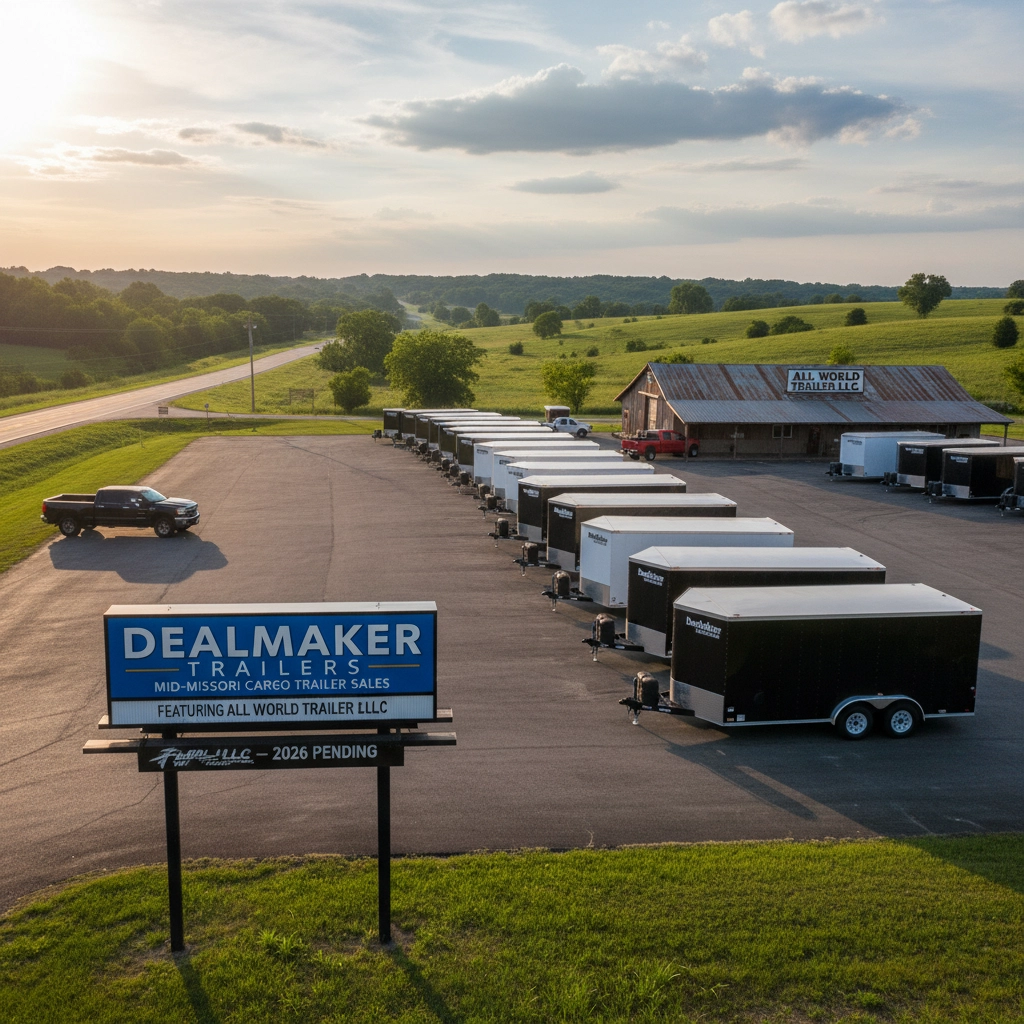Discovering Central Missouri: Route 66 in Missouri, Stories & Stops | Amerishop focus on Missouri
- Randy Dinwiddie

- Oct 3
- 6 min read
Updated: Oct 6


Missouri holds a unique place in American road trip history as both the birthplace and heart of the legendary Route 66. Known affectionately as the "Mother Road," this iconic highway stretches 2,448 miles from Chicago to Santa Monica, but its Missouri section tells some of the most compelling stories of American wanderlust, entrepreneurship, and the open road spirit that defined a generation.
The Birth of America's Highway
Route 66's story begins right here in Missouri, where Cyrus Avery, a Tulsa businessman, first envisioned a highway that would connect the heartland to the Pacific Coast. In 1926, when the federal government established the numbered highway system, Missouri became home to 317 miles of what would become America's most famous road. The highway entered the state near Joplin, wound its way through Springfield, rolled past Lebanon and Rolla, meandered through St. Louis, and crossed the mighty Mississippi River into Illinois.
But Route 66 wasn't just about getting from point A to point B, it became the lifeline for thousands of families during the Dust Bowl era of the 1930s. John Steinbeck immortalized this migration in "The Grapes of Wrath," calling Route 66 the "mother road" that carried desperate families west in search of better lives. Missouri's section saw countless jalopy-loads of "Okies" and other migrants, their worldly possessions strapped to their cars, hoping for a fresh start in California.

Stories from the Mother Road's Golden Age
The 1950s and 1960s marked Route 66's golden era, when post-war prosperity meant families had money to travel and cars became symbols of freedom. Missouri's stretch buzzed with activity as classic American road culture flourished. Drive-in theaters, motor courts, and neon-lit diners popped up like wildflowers along the route.
One of the most colorful characters was Jesse James, no, not the outlaw, but a different Jesse James who owned a string of tourist courts along Missouri's Route 66. This James understood that travelers needed more than just a bed for the night; they wanted an experience. His courts featured Wild West themes, complete with fake gunfight shows and cowboys who'd pose for photos with tourists' children.
The real Jesse James (the outlaw) actually has connections to Missouri's Route 66 as well. Legend has it that the notorious gang used the caves that would later become Meramec Caverns as hideouts, utilizing the underground river system for dramatic escapes when law enforcement got too close.
St. Louis: Gateway to Adventure
Your Route 66 journey through Missouri likely begins or ends in St. Louis, home to the magnificent Gateway Arch. This 630-foot stainless steel monument isn't just impressive to look at, it's a testament to America's westward expansion spirit that Route 66 embodied. The arch opened in 1967, just as Route 66 was being decommissioned, creating a symbolic passing of the torch from the age of covered wagons to the era of automobile exploration.
Don't miss the Chain of Rocks Bridge, where Route 66 once carried traffic across the Mississippi River. This mile-long bridge features an unusual 22-degree bend in the middle, an engineering quirk that photographers and bridge enthusiasts love. Today it's a pedestrian walkway where you can literally walk in the footsteps of millions of Route 66 travelers.
For a taste of authentic Route 66 culture, stop at Ted Drewes Frozen Custard, serving travelers since 1941. Their concrete, a custard so thick you can turn the cup upside down, has become legendary among Route 66 enthusiasts. The original neon sign and walk-up window maintain that classic roadside stand atmosphere.

Underground Wonders and Small-Town Charm
About an hour southwest of St. Louis, you'll discover Meramec Caverns near Stanton, one of Missouri's crown jewels of roadside attractions. These limestone caves have been wowing visitors since 1935, but their history goes back much further. Native Americans used these caverns long before European settlement, and during the Civil War, they served as a saltpeter mine for gunpowder production.
The caverns' most famous marketing gimmick was painting advertisements on barn roofs across the Midwest, "Meramec Caverns, Stanton, MO" could be seen from Iowa to Texas. While most of these barn ads have faded, you can still spot one between St. Clair and Stanton, a nostalgic reminder of how Route 66 businesses marketed themselves in the pre-internet age.
Cuba, Missouri, takes small-town Route 66 charm to an artistic level. This community of about 3,300 people officially became the "Route 66 Mural City" in 2002, thanks to a grassroots beautification effort called Viva Cuba. Twelve official murals plus dozens of unofficial ones tell the story of both local history and Route 66 culture. The Missouri Hick BBQ serves up some of the best ribs you'll find anywhere along the Mother Road, served in an Old West atmosphere that perfectly captures the Route 66 spirit.

Roadside Oddities and Classic Americana
Route 66's appeal partly comes from its embrace of the wonderfully weird. Missouri delivers on this front with attractions like the Route 66 Red Rocker in Fanning, an enormous rocking chair that once held the Guinness World Record. Built in 2008 at the Fanning 66 Outpost, it remains the largest rocker along Route 66 and provides the kind of kitschy photo opportunity that social media was made for.
Then there's Uranus, Missouri (yes, really), which has turned its amusing name into a tourist attraction. The Uranus Fudge Factory and General Store combines humor with genuine Route 66 hospitality, proving that sometimes the best travel experiences come from places that don't take themselves too seriously.
Gary's Gay Parita in Ash Grove represents the preservation side of Route 66 culture. This carefully reconstructed 1930s Sinclair Gas Station, complete with original pumps and Route 66 memorabilia, transports visitors back to the golden age of American motoring when gas station attendants checked your oil and cleaned your windshield.

Where Movies Come Alive
The 66 Drive-In Theatre near Carthage keeps alive one of America's greatest contributions to car culture. Operating from April through September, this authentic drive-in theater shows double features with those classic intermission cartoons that remind you to visit the snack bar. There's something magical about watching a movie under the stars from the comfort of your car: it's quintessentially Route 66.
Preserving the Legacy
Route 66 was officially decommissioned in 1985, replaced by faster interstate highways that bypassed small towns and roadside attractions. But Missouri has worked hard to preserve its Route 66 heritage. Route 66 State Park near Eureka operates from a restored 1935 roadhouse called the Bridgehead Inn, offering exhibits about the highway's cultural impact while providing access to the scenic Meramec River.
The Route 66 Museum in Lebanon houses an impressive collection of memorabilia in what was once the Laclede County Library. Their salt and pepper shaker collection from various Route 66 restaurants might seem quirky, but it represents the personal connections travelers formed with roadside establishments: the kind of relationships that made Route 66 more than just a highway.
Missouri's Wagon Wheel Motel in Cuba holds the distinction of being the longest continuously-operating motel on Route 66, with more than 80 years in business. Staying here isn't just accommodation: it's participating in living history.

The Spirit Lives On
Today's Missouri Route 66 experience combines preservation with evolution. While you'll find meticulously maintained vintage attractions and museums dedicated to the highway's heyday, you'll also discover new businesses that capture the Route 66 spirit of hospitality, adventure, and uniquely American entrepreneurship.
Whether you're driving the entire route or just exploring Missouri's section, remember that Route 66 was never really about the destination: it was about the journey, the people you met, the stories you collected, and the freedom of the open road. Missouri's 317 miles offer all of that and more, from underground caves to towering monuments, from small-town murals to big-city landmarks.
The Mother Road may be officially retired, but its spirit lives on in every mile marker, every vintage motel sign, and every roadside attraction that still welcomes travelers with that distinctive Route 66 hospitality. In Missouri, you're not just driving a highway; you're traveling through the heart of American road trip culture.
















































Comments